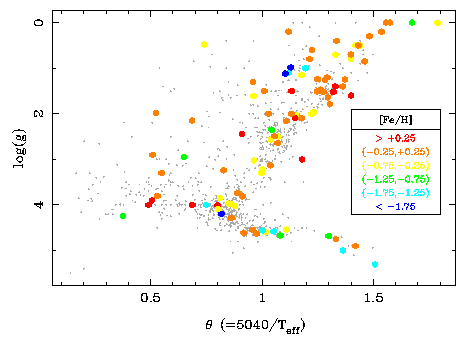
(click to enlarge)
Figure 1: Pseudo HR-diagram (gravity vs. temperature) showing the whole
optical stellar library (small dots), and the stars already observed for this
project in the K band (big filled circles). Colors indicate metallicity.
Abstract
Stellar population synthesis models are crucial for the understanding of the large amount of data which is being gathered for galaxies at low and high redshift, and provide the only way to compare the real world with the theoretical framework. The best models require extensive empirical stellar spectral libraries, which at present are starting to be quite complete in the optical range. However the situation is different in the near-infrared, which observational windows have been, until recently, poorly exploited. This is specially due to the lack of appropriate instrumentation. Here we present the preliminary results of an ongoing observational program aimed to overcome this problem and to provide a stellar library in the K band with the required coverage of physical stellar parameters: effective temperature, gravity, metallicity and non-solar abundance ratios. In particular, the CO feature at 2.3 micron is a very promising spectroscopic line-strength index that will help to face outstanding problems in galaxy formation and evolution. In addition, this library will be useful for other purposes, like the study of highly reddened objects and the spectral classification of late type stars.
Previous work
Up to date, several authors have already compiled, for different purposes, small libraries in the K band (Johnson & Méndez 1970; Kleinman & Hall 1986; Lançon & Rocca-Volmerange 1992; Ali et al. 1995; Hanson et al. 1996; Wallace & Hinkle 1997). Due to the high S/N ratio of their spectra, it is interesting to highlight the library of Kleinman & Hall (1986), which contains 26 stars, with a spectral resolution around R=3000, but with only solar abundances. Unfortunately, those libraries do not offer by far, sufficient variety of high quality spectra: there is no range in metallicity, and stars with non-solar abundance ratios are not included. Very recently, Ivanov et al. (2004) have just presented a larger library comprising the infrared spectra of 218 late type stars at R=2000-3000, spanning a range of [Fe/H] from -2.2 to +0.3. However these stars were not flux calibrated. In the near future we are planning to combine Ivanov's sample with our stellar library (which is relative flux calibrated), in order to provide a more complete empirical SED library in the K band.
The sample
At present, the stellar library comprises 97 stars observed at R=2500-3000, using OMEGA-CASS, the near-infrared spectrograph at the 3.5 m telescope in the Calar Alto Observatory (Almería, Spain). The stars have been selected to cover ample ranges in the stellar atmospheric parameters (Figure 1), namely
| Parameter | Range |
| Teff | [2500, 13400] K |
| log(g) | [0.0, 5.3] |
| [Fe/H] | [-2.6, +1.0] |

The CO index
In the following three panels (Figure 2) we show examples of typical spectra obtained with OMEGA-CASS in the K band for similar stars but with different effective temperature (left panel), metallicity (center panel), and surface gravity (right panel). The location of the band-passes defining the CO index at around 2.29 micron is shown with shaded regions. Two other CO features (at around 2.32 and 2.35 micron) are also clearly visible.
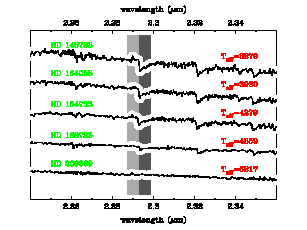 |
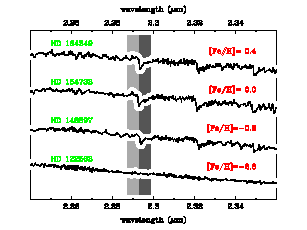 |
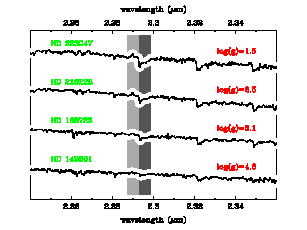 |
| (click to enlarge) | (click to enlarge) | (click to enlarge) |
The CO index as a function of stellar atmospheric parameters
The measured CO index at 2.3 micron is shown in Figure 3 as a function of temperature (left panel), metallicity (center panel) and surface gravity (right panel). Symbol sizes are inversely proportional to gravity, and color indicates metallicity (as indicated in the inset of Figure 1). The error bars have been computed with a parallel treatment of data and error frames throughout the whole reduction procedure (e.g. see Cardiel et al. 2003). As expected, the CO feature vanishes (i.e., the CO index tends to unity) with increasing temperature and decreasing metallicity.
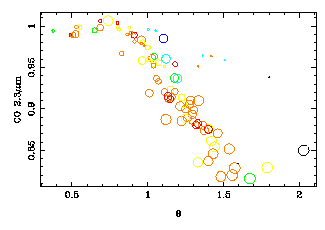 |
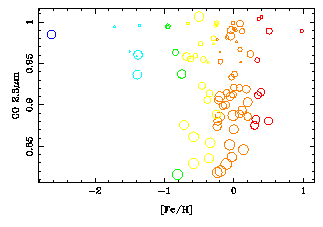 |
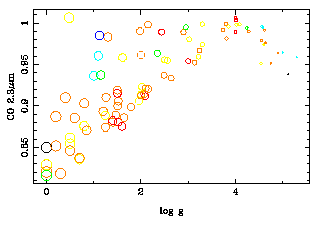 |
| (click to enlarge) | (click to enlarge) | (click to enlarge) |
The fitting functions
Following a procedure similar to that employed by Gorgas et al. (1999) (see also Gorgas et al. 1993, and Worthey et al. 1994), preliminary fitting functions for the CO index have been computed as polynomials of the atmospheric parameters in two possible functional forms,




As an example, in Figures 4 and 5 we show the projections of one set of fitting functions after removing the effect of gravity and metallicity, respectively. These fitting functions quantify the behavior already shown in Figure 4 but, in addition, they allow the computation of the CO index for any arbitrary selection of input stellar atmospheric parameters.
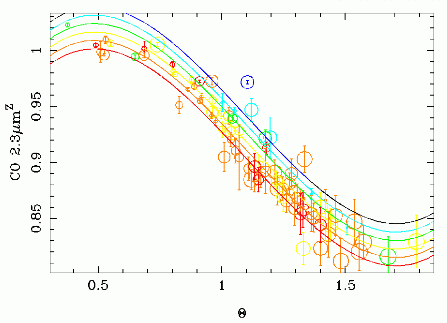 |
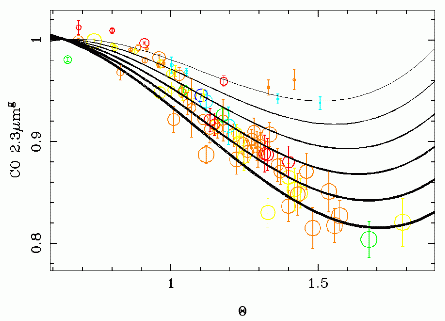 |
| (click to enlarge) | (click to enlarge) |
Incorporating the library into stellar population models
Evolutionary stellar population synthesis models can incorporate the information contained in empirical stellar libraries in two different ways: either by computing the whole SED of the composite stellar population (preserving the spectral resolution of the input libraries, see e.g. Vazdekis et al. 2003, and taking into account that empirical stellar libraries are usually incomplete sampling of the atmospheric stellar parameter space), or by employing intermediate fitting functions of the spectroscopic features available in the considered wavelength range (e.g. Worthey 1994). The use of empirical fitting functions allow the computation of line-strength indices for any combination of input parameters. However, and since the empirical fitting functions only predict the value of a given line-strength feature for a fixed set of stellar atmospheric parameters, the shape of the spectrum that leads to such value is therefore unknown. To insert the fitting function predictions into the evolutionary synthesis models it is necessary to use the local continuum of each single star in the SED library as a reference continuum level. In this way it is possible to weight the luminosity contribution of each type of star, in the neighborhood wavelength region of each index, to obtain the final line-strength prediction.
References